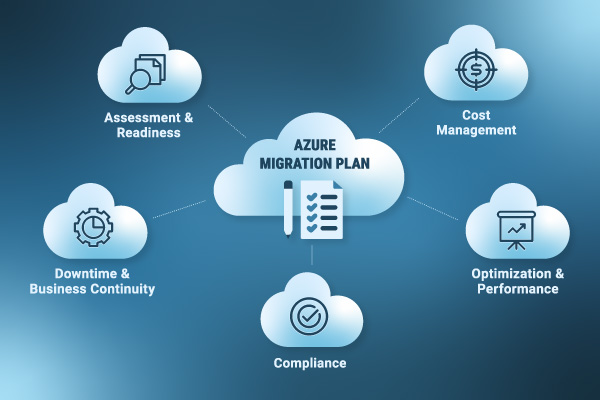Why Businesses Are Moving to the Azure Cloud
Running a business on old, on-premises servers is like driving an aging car that constantly needs repairs. The equipment occupies space, requires frequent maintenance, and costs more to upgrade every year. When something breaks, everything grinds to a halt. Expanding means buying more hardware, hiring more IT staff, and hoping nothing fails at the wrong time.
Now, imagine a different scenario. Instead of managing physical servers, your business moves to the cloud. No more expensive upgrades, unexpected failures, or worrying about storage limits. The cloud scales as your business grows, keeps costs in check, and strengthens security—all with less effort from your IT team.
But what’s the best and safest way to move to the cloud? Moving to the cloud offers flexibility and security, but without a well-structured migration plan, the transition can lead to unexpected costs, downtime, and security risks. A solid plan ensures a smooth shift from rigid, expensive systems to a cloud environment that meets business needs efficiently and securely.
That’s why a free cloud migration project plan is so valuable. It helps businesses transition smoothly, avoid costly mistakes, and maximize the benefits of cloud adoption.
One important tool for ongoing cloud success is VBox. Rather than being used during migration, VBox helps businesses optimize their Azure environment after the move. It continuously analyzes IT setups, identifies cost-saving opportunities, and enhances security and operations. This commitment to post-migration success ensures businesses get the most value from their cloud investment. Here are five ways a good migration plan—combined with the right strategy and ongoing optimization tools like VBox—can save money and reduce risk.
1. An Azure Migration Plan Prevents Expensive Mistakes
Moving to the cloud without a structured plan is like relocating to a new home without labeling your boxes. You may bring things you don’t need.
You might misplace important items. You could also waste time reorganizing later. In Azure cloud migration, these missteps translate into higher costs, security risks, and operational inefficiencies.
Without a well-defined cloud migration strategy, businesses often:
- Move unnecessary applications to the cloud, increasing costs:
Not every application belongs in the cloud. Some legacy systems are outdated, inefficient, or no longer essential. Migrating them adds storage, processing, and licensing expenses without real business value. A lack of assessment can result in unnecessary costs and wasted resources. - Underestimate cloud expenses, leading to budget overruns:
Cloud pricing changes often. Businesses that do not estimate costs well can face unexpected charges. These charges can come from data transfer, computing power, or services that are not fully used. Without financial planning, cloud expenses can quickly spiral out of control. - Overlook security and compliance measures, leaving data exposed:
Moving data to the cloud without strong security policies can make businesses vulnerable to cyber threats and compliance issues. This could result in data breaches, legal penalties, and reputational damage.
A well-structured Azure cloud migration plan ensures that businesses:
- Identify which applications should move:
Companies must assess their IT landscape and determine which applications should migrate, be restructured, or be retired. This prevents inefficiencies and reduces unnecessary costs. - Remove outdated or redundant software, reducing storage costs:
By eliminating unused or duplicate applications, businesses can free up cloud resources and optimize costs. - Accurately estimate cloud expenses:
A migration plan includes cost forecasting and pricing model evaluations, ensuring businesses only pay for what they need and avoid budget overruns. - Implement security measures to protect data:
Security should be built into the migration process. This means applying access controls, encryption, and compliance checks to prevent breaches and regulatory issues.
A good migration plan is important for businesses. It helps them save money. It also and improves security. Additionally, it ensures a smooth transition to the cloud without any surprises.
2. The Cloud Lowers IT Costs
Running an on-premises data center is like owning a fleet of cars. You have to pay for fuel, insurance, maintenance, and surprise repairs. If a server fails, repair costs can be unpredictable and costly.
Migrating to the cloud helps businesses eliminate these unpredictable expenses while making IT spending more efficient.
A cloud-based model allows businesses to:
- Eliminate hardware costs
- Businesses no longer need to purchase, upgrade, or maintain physical servers. Instead, they leverage cloud infrastructure, paying only for the resources they use.
- Scale resources up or down based on actual usage
- Unlike on-premises environments where capacity is fixed and costly, the cloud provides on-demand scalability. Businesses can adjust their cloud resources in real time, preventing over-provisioning and reducing waste.
- Automate cloud cost optimization
- Cloud providers offer cost-saving tools and AI-driven insights that help businesses right-size their infrastructure. This ensures they only pay for what they actually use.
With a cost-effective Azure cloud migration strategy, organizations can:
- Reduce hardware, maintenance, and IT labor costs
- By shifting to the cloud, companies eliminate physical infrastructure expenses, hardware replacements, and in-house server management costs.
- Avoid expensive server failures
- Cloud providers handle infrastructure maintenance and uptime, reducing the risk of unexpected repair expenses.
- Benefit from predictable, usage-based pricing
- Cloud services operate on a pay-as-you-go model, allowing businesses to budget more effectively and avoid surprise costs.
By adopting the cloud, businesses lower IT expenses, reduce financial risk, and optimize spending for long-term growth.
3. Security and Compliance Are Built Into the Plan
Moving data to the cloud without a security plan is like moving into a new house and not locking the doors. Without a good security framework, businesses face risks like data breaches and compliance violations. These issues can lead to financial losses and harm to their reputation.
A structured cloud migration plan ensures security is prioritized from the start, including:
- End-to-end encryption to protect sensitive data:
Encrypting data at rest and in transit ensures that even if cybercriminals intercept it, the information remains unreadable. - Strict access controls to prevent unauthorized use:
Implementing role-based access control (RBAC) ensures that only authorized personnel can access critical cloud resources. - Regular security assessments to identify vulnerabilities:
A structured plan includes ongoing security monitoring, penetration testing, and automated threat detection to protect against cyber threats. - Compliance measures for regulations like GDPR, HIPAA, and SOC 2:
Businesses must ensure their cloud environment aligns with industry regulations and legal requirements, avoiding costly penalties.
Companies that fail to secure their cloud environments risk:
- Legal penalties for compliance violations:
Non-compliance with data protection laws can lead to fines, lawsuits, and operational restrictions. - Financial losses from cyberattacks:
A security breach can compromise sensitive business and customer data, leading to revenue losses and reputational damage. - Operational disruptions due to security breaches:
Cyberattacks can halt operations, disrupt services, and cause data loss, leading to downtime and reduced productivity.
By implementing security best practices from the start, businesses protect their assets, maintain regulatory compliance, and minimize security risks.
4. Businesses Minimize Downtime with a Cloud Migration Plan
Imagine an e-commerce website crashing on Black Friday—every minute of downtime means lost revenue and frustrated customers.
A poorly planned Azure cloud migration can lead to:
- Extended outages that disrupt operations
- Data loss that affects business continuity
- Customer dissatisfaction due to unreliable services
With a structured cloud migration approach, businesses can:
- Instead of moving everything at once, businesses can migrate in stages, ensuring services remain online.
- Test systems before going live
- Running cloud performance tests, load balancing simulations, and rollback plans ensures a smooth transition.
- Create backup.
- A strong disaster recovery strategy prevents data loss and downtime in case of unexpected issues.
By carefully planning their migration, businesses ensure uninterrupted service, maintain customer satisfaction, and protect revenue streams.
5. Businesses Keep Costs Under Control with Continuous Optimization
Cloud migration isn’t a one-time event—it’s an ongoing process. Without continuous monitoring, companies may overspend on underutilized cloud services. That’s where VBox comes in. It helps businesses optimize their Azure environment post-migration by identifying cost-saving opportunities, eliminating waste, and ensuring resources are used efficiently. With tools like VBox, companies can keep cloud costs under control while maintaining performance and security.
A structured Azure cloud migration strategy includes:
- Real-time monitoring of cloud usage and expenses
- Businesses track resource consumption to prevent wasteful spending.
- Automated cost-saving recommendations
- Cloud platforms provide AI-driven insights and optimization tools to adjust workloads dynamically.
- Regular audits to fine-tune cloud service allocation
- Periodic evaluations help identify unused resources and optimize performance.
With continuous cloud cost management, businesses can:
- Prevent budget overruns by tracking cloud expenses
- Optimize cloud performance without unnecessary costs
- Ensure long-term savings through proactive resource allocation
By monitoring, adjusting, and optimizing their cloud environment, companies maximize cost efficiency and long-term cloud ROI.
A Smarter, Cost-Effective Way to Move to the Cloud
Cloud migration doesn’t have to be complicated—or expensive. But without a clear strategy, businesses often run into unexpected costs, security gaps, and performance issues. That’s why VIAcode offers a free Azure cloud migration assessment, helping companies transition smoothly while keeping costs under control.
With this expert-driven migration plan, your business gets:
- A customized roadmap tailored to your IT environment, ensuring a seamless transition
- A financial assessment to identify cost-saving opportunities and optimize cloud spending
- Security and compliance evaluations to minimize risk and meet industry standards
- Expert cloud guidance to help you avoid common migration pitfalls and maximize performance
This free assessment gives you a clear plan. It helps you move to the cloud confidently. You can do this without extra costs or disruptions.
Take the first step toward a smarter Azure cloud migration.
Claim your free cloud migration plan today.
A Free Cloud Migration Plan is a Smart Business Decision
Migrating to the cloud is a major decision, and having a well-structured plan is essential. Whether you’re moving from on-premises servers, a private cloud, or another public cloud provider, the right strategy ensures:
- Minimal disruptions for a seamless transition
- Optimized cloud costs to prevent overspending
- Stronger security to protect sensitive data
- Regulatory compliance to meet industry standards
- Scalable infrastructure to support future growth
Don’t leave your Azure migration to chance. With expert help and a free, custom migration plan from VIAcode, you can move to the cloud safely and affordably.
Take advantage of VIAcode’s Free Azure Cloud Migration offer today and start optimizing your cloud journey.

